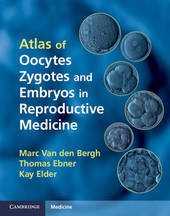
|
Atlas of Oocytes, Zygotes and Embryos in Reproductive Medicine Hardback with CD-ROM
Mixed media product
Main Details
| Title |
Atlas of Oocytes, Zygotes and Embryos in Reproductive Medicine Hardback with CD-ROM
|
| Authors and Contributors |
By (author) Marc Van den Bergh
|
|
By (author) Thomas Ebner
|
|
By (author) Kay Elder
|
| Physical Properties |
| Format:Mixed media product | | Pages:272 | | Dimensions(mm): Height 283,Width 223 |
|
| ISBN/Barcode |
9781107004641
|
| Classifications | Dewey:612.64 |
|---|
| Audience | | Professional & Vocational | |
|---|
| Illustrations |
790 Halftones, color
|
|
Publishing Details |
| Publisher |
Cambridge University Press
|
| Imprint |
Cambridge University Press
|
| Publication Date |
5 July 2012 |
| Publication Country |
United Kingdom
|
Description
The assessment and selection of oocytes and embryos is fundamental to the live birth rate data of all IVF units, the parameter that is used to gauge a clinic's success and credibility. This new atlas contains over 1000 high-quality images of oocytes, zygotes and embryos, presented with accompanying data on indications for treatment, stimulation type and duration, as well as short medical histories of each couple and final outcome of treatment. All images in the book can be downloaded from the accompanying CD-ROM. Structured on a patient-by-patient basis, the atlas describes 100 clinically documented case studies that follow the evolution of oocytes and zygotes between day two and day five. Pronuclear morphology and synchrony as well as embryo morphology are reported and described for each case. Written and produced by experienced embryologists, this practical atlas is an important resource for clinical embryologists and physicians in reproductive medicine.
Author Biography
Marc Van den Bergh is Senior Clinical Embryologist and Laboratory Director of the Fertility Laboratory, Kantonsspital Baden, Switzerland. Thomas Ebner is Scientific Lab Director at the Landes- Frauen- und Kinderklinik, Linz, Austria. Kay Elder is Senior Research Scientist, Bourn Hall Clinic, Bourn, Cambridge, UK.
Reviews'A great new book for embryologists, although it may also be of interest to all people working in reproductive medicine, and patients too.' The Bulletin of the Royal College of Pathologists
|